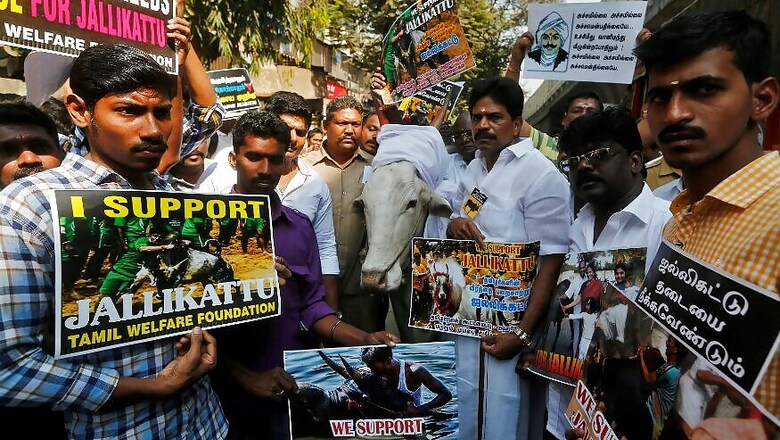
views
Chennai: The waning ranks of fans, participants and stake-holders of the Tamil martial sport of ‘Jallikattu’, or bull-taming, could not have asked for more. By seeking a permanent ban on the same, animal rights activists, who also took up the cause of humans who were being gored to death or injured for life, made Jallikattu an everyday word.
One year after the massive ‘Marina protests’ on the sandy beaches of Tamil Nadu’s capital city, Chennai, reverberated in the traditional Jallikattu country down south, the nation is still asking, “What Jallikattu? Why Jallikattu protests?” The Supreme Court that had banned the sport in 2014 has since reopened the case, and a Constitution Bench is set to decide if the martial sport formed a part of a people’s ‘culture’, protected under Article 29 (1) of the Constitution.
By all accounts, Jallikattu is not only just a part of Tamil culture, but has a pan-Indian presence as well. The Hindu religious treatise, Srimad Bhagawatham, dating back to centuries and millennia, says that on one occasion Lord Krishna tamed not one, but seven bulls, to win the hand of Nachiketi, Kosala princess, as ordained by her father, the King. This story finds mention in the Tamil Vaishnavite poetic collective, the ‘Naalayira Dhivya Prabantham’, written/compiled a thousand years ago. The Tamil literary works of ‘Mullai Kali’, forming a part of the larger ‘Kali- Thogai’ compilation, dating back to the Sangam era, some 2,000 years ago, too mentions Jallikattu. So do other Tamil poetic works of the time.
In contemporary terms, yes, Jallikattu is played out not only in a particular region or sub-region of the state, nor is it the same sport that is in popular imagination being practised in other parts of present-day Tamil Nadu. Barring the southern-most Kanyakumari and possibly Tirunelveli districts, the rest of the state and the people have practised some form of a bull-linked sport during Pongal season. It included the bullock-race, or rekhla race, both in the traditional southern parts of the State, and more so in western Tamil Nadu, in and around the industrial capital of ‘Coimbatore’ and the hosiery town, Tiruppur. In the northern districts, there have been other forms of the sport, involving the bull/bullock, and it has been there for decades and centuries. By the same token, multiple communities, often, yes, dominant communities, in various regions and sub-regions of the State, have been promoting and participating in the local sport that went by different names but fall within the larger identification of ‘Jallikattu’ without necessarily being Jallikattu proper.
In fact, the court-ordered ban itself flowed only from a village-head seeking permission to conduct a rekhla race, and did not directly involve Jallikattu. The Madurai Bench of the Madras High Court banned the sport in 2004, and the rest is history. Even otherwise, Jallikattu at its worst, was about holding the bull by the horn and literally so. Other forms, as now approved by the Supreme Court, first in 2009, when it cleared the facilitating Tamil Nadu law, includes holding the bull by its prominent hump, without getting hurt by the animal’s horns. If there are still violations of the animal’s rights and safety regulations, it is in enforcement, where successive state governments seem to have failed, despite their own legislative and Executive commitments to the apex court, and more than once.
Hurt sentiments
Yet, the protests of Pongal-2017 were not just about the Jallikattu ban alone. It became a point of contact, an immediate purpose for collective expression, an expression of hurt, neglect and denial that the state’s population had been feeling for long, over issues such as the Cauvery water dispute and the Mullaperiyar storage case, involving neighbouring states of Karnataka and Kerala, respectively.
In both cases, the respective states were happily violating successive orders of the Supreme Court, no questions asked by the Centre per se, or no provision made in the Constitution, to make them accountable. The tipping-point was reached when the Centre, represented by then Attorney-General Mukul Rohatgi told the Supreme Court, one fine morning in October 2016, that it did not have powers to order Cauvery waters to a parched Tamil Nadu for irrigation, and it was the job of the Legislature, Parliament in this case.
It was a negation of the Tamils’ rights, and Tamil Nadu’s arguments over the previous decades, attested by the Inter-State Cauvery Waters Tribunal under the law, the Supreme Court and the very same Union of India, too. On the one hand, even apolitical sections in Tamil Nadu, unaffected by the denial of Cauvery waters, so to say, were shocked beyond belief. Simultaneously, the Supreme Court, through October 2016, was telling the state and the people, during the course of the periodically revived hearing of the case, that Jallikattu was a banned sport and could not be staged or practised, anymore. The Centre, which could not enforce the SC directions in the Cauvery and Mullaperiyar cases, was seen as more than eager to enforce the Jallikattu ban, whichever party or leader was in power at the Centre.
Hindutva agenda?
If this hurt and denial was the immediate provocation for the success of the Jallikattu protests, professionalisation or the organisation, without any organisers per se, through last-minute social media calls, should have shown the powers-that-be that their methods could cut and hurt both ways. The accidental decision to shift the venue of the annual protests of the previous decade to the Chennai, and to the sprawling Marina sands, meant that there was ready access for and to the national media, which too has often been accused of ignoring everything non-Delhi, non-Mumbai, and non-Hindi heartland, the ‘cow belt’ in this case. The latter-day coverage of ‘cow-slaughter ban’ and attendant killings of ‘beef-eaters’ should hold a candle, or video-lights, on the charge of the ‘Rest of India’ vs the perceived ‘Best of India’.
Today, when a Constitution Bench is to decide on the ‘cultural’ relevance of Jallikattu and related martial sport, including those in Karnataka and Maharashtra, question arises if the expansion of Article 29 (1) to cover non-traditional aspects of Indian culture, to include ‘non-minority’ rights would hurt larger ‘Indian-ness’ and/or the larger ‘Hindutva agenda’ of the present-day rulers. Either way, it is a serious issue that the court has to agitate carefully, and may have to come up with guidelines for future applications in similar situations and near-similar cases that may go beyond a martial sport.
It is thus that the Supreme Court, having decided that ‘instant triple talaq’ prevalent in the Muslim community in the country, was not ‘custom’ acceptable to the law, has referred to a larger, Constitution Bench, questioning the tradition of not allowing women in re-productive age-group, to enter the southern Sabarimala hill shrine of Lord Ayyappa in neighbouring Kerala State. The question may soon arise if the concept of a ‘Hindu Undivided Family’ (HUF) should still be acceptable to the nation’s income-tax law, which otherwise is ‘secular’.
If nothing else, like the ubiquitous ‘Basic Structure’ theory, propounded in the famous ‘Kesavananda Bharti case’ (1973) and without actually defining what it was, and ‘creamy layer’ in the ‘Mandal case’ (Indra Sawhney vs State of Karnataka, 1993), the court may have to come up with a broad idea of what all could constitute ‘culture’ under Article 29 (1) of the Constitution, as a future reference-point and touchstone. For now, however, in the Jallikattu case, the Animal Welfare Board of India (AWBI), a creature and creation of the law, under the Union Ministry of Animal Welfare and Environment, is no more playing both the petitioner and umpire at the same time, the latter role assigned to it by the Supreme Court, during the run-up to the 2014 verdict, when the Board would set the rules and also rule on alleged violations.
The petitioner’s job in the present case, flowing from the post-protests enabling law of Tamil Nadu, has now been left to PETA, the international NGO, ‘People for Ethical Treatment of Animals’, which was a co-plaint, earlier. With the result, the AWBI can more confidently than ever tell the Tamil Nadu authorities, the further dos and don’ts to make this year’s Jallikattu season, more law-compliant and less controversial than over the past decade and more. Otherwise, the protests may have given a longer lease to the martial sport than it might have got under the evolving education and employment climate of 21st century Tamil Nadu, with animal rights also coming under a closer watch, especially if and when staged in urban centres, too, as promised by the State Government last year and planned by some organisers for Chennai suburbs, among other centres, this time, at the very least.
Otherwise, the Justice S Rajeswaran Commission of Inquiry, appointed by the State Government, is going into the whys and wherefores of the avoidable (?) that marred the conclusion of an otherwise successful protests on the Marina, which will be remembered even more for the peaceful way that it all went through for close to a week, no threat to any participant, starting with young women, who had joined in thousands without knowing the stranger by her side, many of them staying back for the night, too.
For, at commencement and throughout the protests, a section of the social media was talking about a ‘foreign hand’ conspiring to end Jallikattu and with that strong and sickness-resistant Indian breeds. Others, while acknowledging as much without actually acknowledging as such, would expand the ‘foreign hand’ theme to include religions and their institutions, adding a ‘nationalist angle’, and running down foreign brands of soft-drinks and the like, unconnected to Jallikattu, bulls and breeds, in any which way, but connected they did, all the same!
(N Sathiya Moorthy, Director, Observer Research Foundation, Chennai Chapter, is author of the book, “Jallikattu: New Symbol of Tamil Angst”, Vitasta, 2018).




















Comments
0 comment